Secure Virtual Network Embedding Algorithms for a Software-Defined Network Considering Differences in Resource Value
Abstract
:1. Introduction
- (1)
- We research the relationship between the resource value and its security-level, and we present a MILP formulation that takes into account differences in the resource value to minimize the embedding cost for the SVNE problem.
- (2)
- Two SVNE algorithms are proposed based on node-ranking approaches to reduce the costs of VNE. The node-ranking approaches comprehensively considers the network topology, resources, and security-level attributes.
- (3)
- Extensive simulation experiments are implemented to validate the performance of the proposed algorithms. Simulation results show that our proposed algorithms outperform selected typical algorithms.
2. Related Work
2.1. SVNE Algorithms
2.2. Brief Summary
3. System Model and Evaluation Indicators
3.1. Network Model
3.2. Evaluation Indicators
3.3. Problem Formulation of SVNE
- : a binary variable, its value is 1 if the substrate path lij accommodates the virtual link luv; otherwise, the value is 0.
- : a binary variable, its value is 1 if the virtual node u is embedded onto the substrate node s; otherwise, the value is 0.
4. Proposed Solution
4.1. Node-Ranking Approach
4.2. SVNE Algorithms
| Algorithm 1: T-SVNE Algorithm |
| Input: Gs, Gv, Dhop. Output: embedding solution. 1: Sort the virtual nodes based on the ranking approach; 2: for all virtual node u do 3: Sort physical nodes based on physical node-ranking approach; 4: for all physical node n do 5: if CPU(u) ≤ CPU(n), TCAM (u) ≤ TCAM(n) and SL(u) ≤ SL(n) then 6: Embed virtual node u to physical node n, M(u) = n; 7: break 8: end if 9: end for 10: end for 11: Sort the virtual links based on the bandwidth requirements in descending order; 12: for all virtual links do 13: Use Dijkstra algorithm [1,17,18] to find the shortest path; 14: end for |
4.3. H-SVNE Algorithm
| Algorithm 2: H-SVNE Algorithm |
| Input: Gs, Gv. Output: embedding solution. 1: Sort virtual nodes based on the ranking approach; 2: for all virtual node u do 3: Delete physical nodes do not meet resource and SL requirements; 4: for all physical node n that meet requirements do 5: Initialize BW’(ls)←BW(ls); 6: for all physical node m hosts v that has a link with u do 7: Delete the physical links (BW(luv) > BW’(ls)); 8: Use Dijkstra algorithm to find the shortest path; 9: if there is the shortest path then 10: Calculate BDmn, record information and update BW’(ls); 11 end if 12: end for 13: end for 14: BD matrix element column addition; 15: Sort physical nodes based on NRP; 16: if u is embedded successfully then 17: Update BW(ls) if u is embedded successfully; 18: else 19: break 20: end if 21: end for |
4.4. Time Complexity Analysis
5. Performance Evaluation
5.1. Simulation Settings and Compared Algorithms
5.2. Simulation Results
6. Conclusions
Author Contributions
Funding
Conflicts of Interest
References
- Cao, H.; Wu, S.; Hu, Y.; Mann, R.S.; Liu, Y.; Yang, L.; Zhu, H. An Efficient Energy Cost and Mapping Revenue Strategy for Interdomain NFV-Enabled Networks. IEEE Internet Things J. 2020, 7, 5723–5736. [Google Scholar] [CrossRef]
- Chai, R.; Xie, D.; Luo, L.; Chen, Q. Multi-Objective Optimization-Based Virtual Network Embedding Algorithm for Software-Defined Networking. IEEE Trans. Netw. Serv. Manag. 2020, 17, 532–546. [Google Scholar] [CrossRef]
- Ahmad, I.; Namal, S.; Ylianttila, M.; Gurtov, A. Security in Software Defined Networks: A Survey. IEEE Commun. Surv. Tutor. 2015, 17, 2317–2346. [Google Scholar] [CrossRef]
- Wang, Z.; Wu, J.; Guo, Z.; Cheng, G.; Hu, H. Secure virtual network embedding to mitigate the risk of covert channel attacks. In Proceedings of the 2016 IEEE Conference on Computer Communications Workshops (INFOCOM WKSHPS), San Francisco, CA, USA, 10–14 April 2016; pp. 144–145. [Google Scholar] [CrossRef]
- Cao, H.; Aujla, G.S.; Garg, S.; Kaddoum, G.; Yang, L. Embedding Security Awareness for Virtual Resource Allocation in 5G Hetnets Using Reinforcement Learning. IEEE Commun. Stand. Mag. 2021, 5, 20–27. [Google Scholar] [CrossRef]
- Boutigny, F.; Betge-Brezetz, S.; Debar, H.; Blanc, G.; Lavignotte, A.; Popescu, I. Multi-Provider Secure Virtual Network Embedding. In Proceedings of the 2018 9th IFIP International Conference on New Technologies, Mobility and Security (NTMS), Paris, France, 26–28 February 2018; pp. 1–5. [Google Scholar] [CrossRef]
- Zhang, P.; Wang, C.; Jiang, C.; Benslimane, A. Security-Aware Virtual Network Embedding Algorithm Based on Reinforcement Learning. IEEE Trans. Netw. Sci. Eng. 2021, 8, 1095–1105. [Google Scholar] [CrossRef]
- Zhang, P.; Wang, C.; Jiang, C.; Kumar, N.; Lu, Q. Resource Management and Security Scheme of ICPSs and IoT Based on VNE Algorithm. IEEE Internet Things J. 2021, 1–10. [Google Scholar] [CrossRef]
- Cao, H.; Hu, Y.; Wu, S.; Yang, L. A Novel and Secure Service Function Chains Embedding Framework for NFV-Enabled Networks. In Proceedings of the 2020 IEEE 21st International Symposium on “A World of Wireless, Mobile and Multimedia Networks” (WoWMoM), Cork, Ireland, 31 August–3 September 2020; pp. 433–438. [Google Scholar] [CrossRef]
- Cao, H.; Hu, Y.; Wu, S.; Du, J.; Tian, F.; Aujla, G.S.; Yang, L. NoViSec: Novel Virtual Network Mapping Framework for Secure Software-Defined Networking. In Proceedings of the 2020 IEEE Wireless Communications and Networking Conference Workshops (WCNCW), Seoul, Korea, 6–9 April 2020; pp. 1–6. [Google Scholar] [CrossRef]
- Cao, H.; Hu, Y.; Wang, Q.; Wu, S.; Yang, L. A Blockchain-Based Virtual Network Embedding Algorithm for Secure Software Defined Networking. In Proceedings of the IEEE INFOCOM 2020—IEEE Conference on Computer Communications Workshops (INFOCOM WKSHPS), Toronto, ON, Canada, 6–9 July 2020; pp. 1057–1062. [Google Scholar] [CrossRef]
- Yan, Z.; Ge, J.; Wu, Y.; Li, L.; Li, T. Automatic Virtual Network Embedding: A Deep Reinforcement Learning Approach With Graph Convolutional Networks. IEEE Journal on Selected Areas in Communications 2020, 38, 1040–1057. [Google Scholar] [CrossRef]
- Dehury, C.K.; Sahoo, P.K. DYVINE: Fitness-Based Dynamic Virtual Network Embedding in Cloud Computing. IEEE J. Sel. Areas Commun. 2019, 37, 1029–1045. [Google Scholar] [CrossRef]
- Zhang, P.; Jiang, C.; Pang, X.; Qian, Y. STEC-IoT: A Security Tactic by Virtualizing Edge Computing on IoT. IEEE Internet Things J. 2021, 8, 2459–2467. [Google Scholar] [CrossRef]
- Zhang, P.; Wang, Y.; Kumar, N.; Jiang, C.; Shi, G. A Security and Privacy-Preserving Approach Based on Data Disturbance for Collaborative Edge Computing in Social IoT Systems. IEEE Trans. Comput. Soc. Syst. 2021, 9, 97–108. [Google Scholar] [CrossRef]
- Ling, S.; Muqing, W.; Hou, X. VNE-SDN Algorithms for Different Physical Network Environments. IEEE Access 2020, 8, 178258–178268. [Google Scholar] [CrossRef]
- Cao, H.; Yang, L.; Zhu, H. Novel Node-Ranking Approach and Multiple Topology Attributes-Based Embedding Algorithm for Single-Domain Virtual Network Embedding. IEEE Internet Things J. 2018, 5, 108–120. [Google Scholar] [CrossRef]
- Zhang, Z.; Cao, H.; Su, S.; Li, W. Energy Aware Virtual Network Migration. IEEE Trans. Cloud Comput. 2020. [Google Scholar] [CrossRef]
- Su, Y.; Meng, X.; Kang, Q.; Han, X. Dynamic Virtual Network Reconfiguration Method for Hybrid Multiple Failures Based on Weighted Relative Entropy. Entropy 2018, 20, 711. [Google Scholar] [CrossRef] [PubMed] [Green Version]
- Zhang, P.; Yao, H.; Liu, Y. Virtual Network Embedding Based on Computing, Network, and Storage Resource Constraints. IEEE Internet Things J. 2018, 5, 3298–3304. [Google Scholar] [CrossRef]
- Dhelim, S.; Ning, H.; Farha, F.; Chen, L.; Atzori, L.; Daneshmand, M. IoT-Enabled Social Relationships Meet Artificial Social Intelligence. IEEE Internet Things J. 2021, 8, 17817–17828. [Google Scholar] [CrossRef]
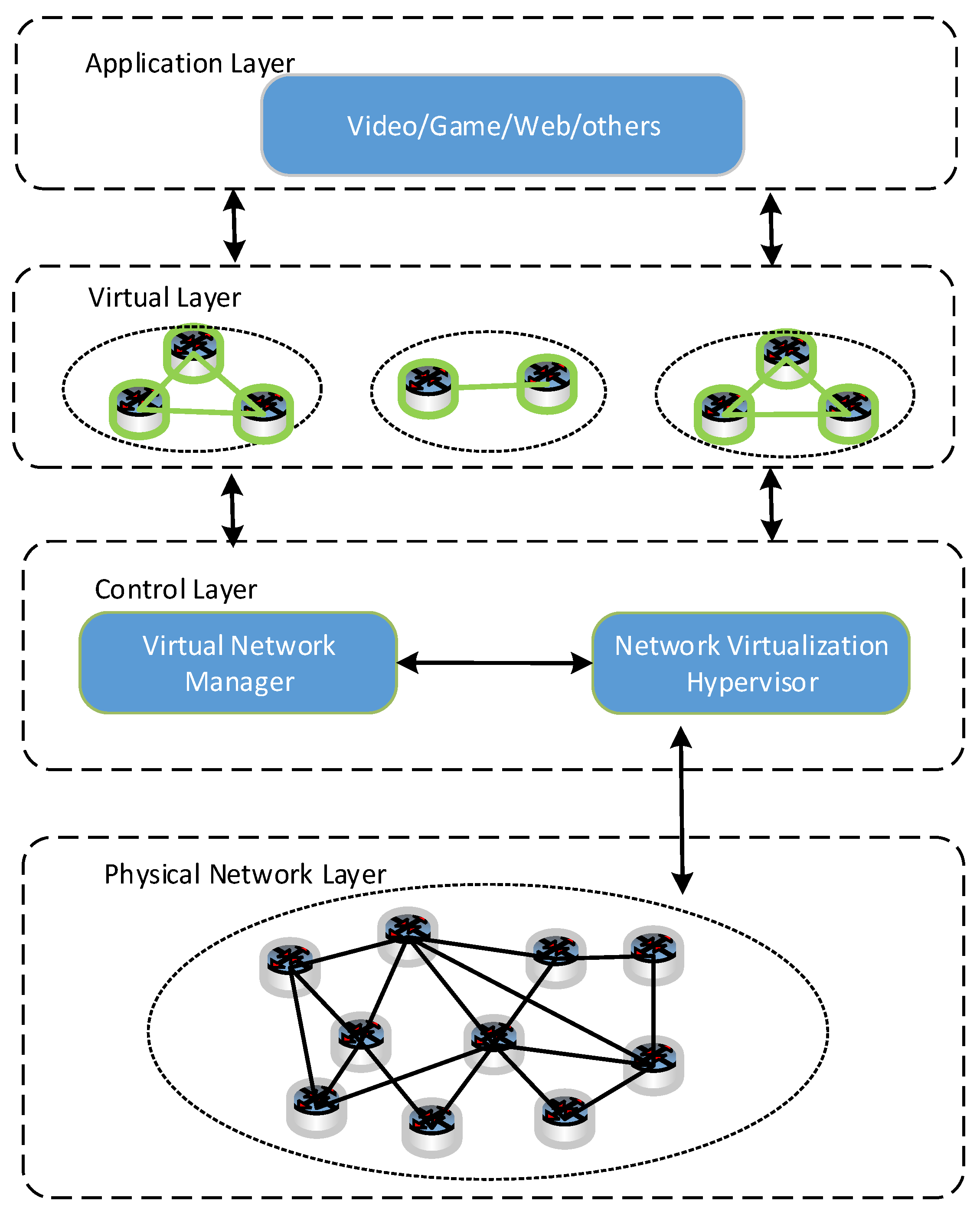
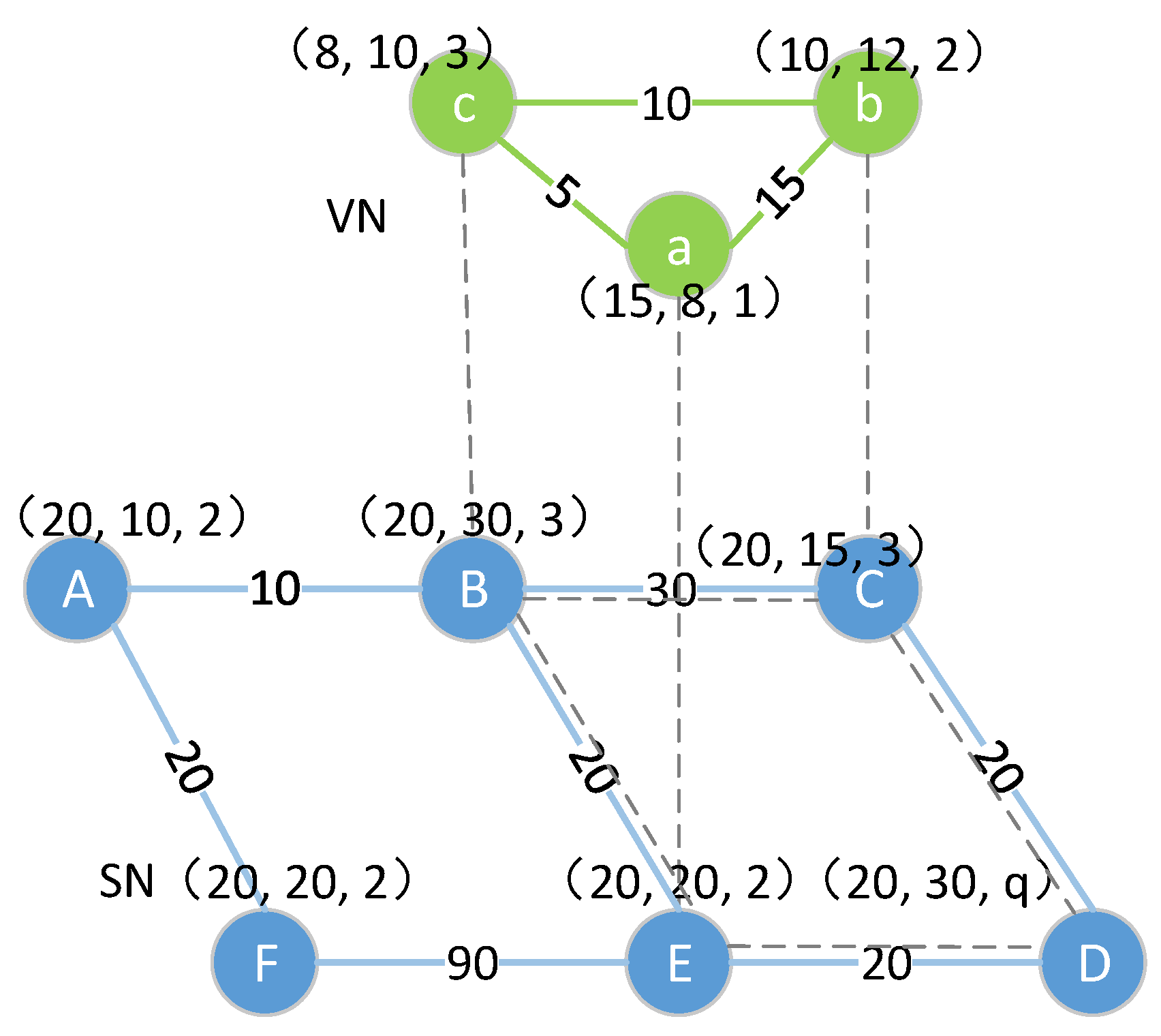
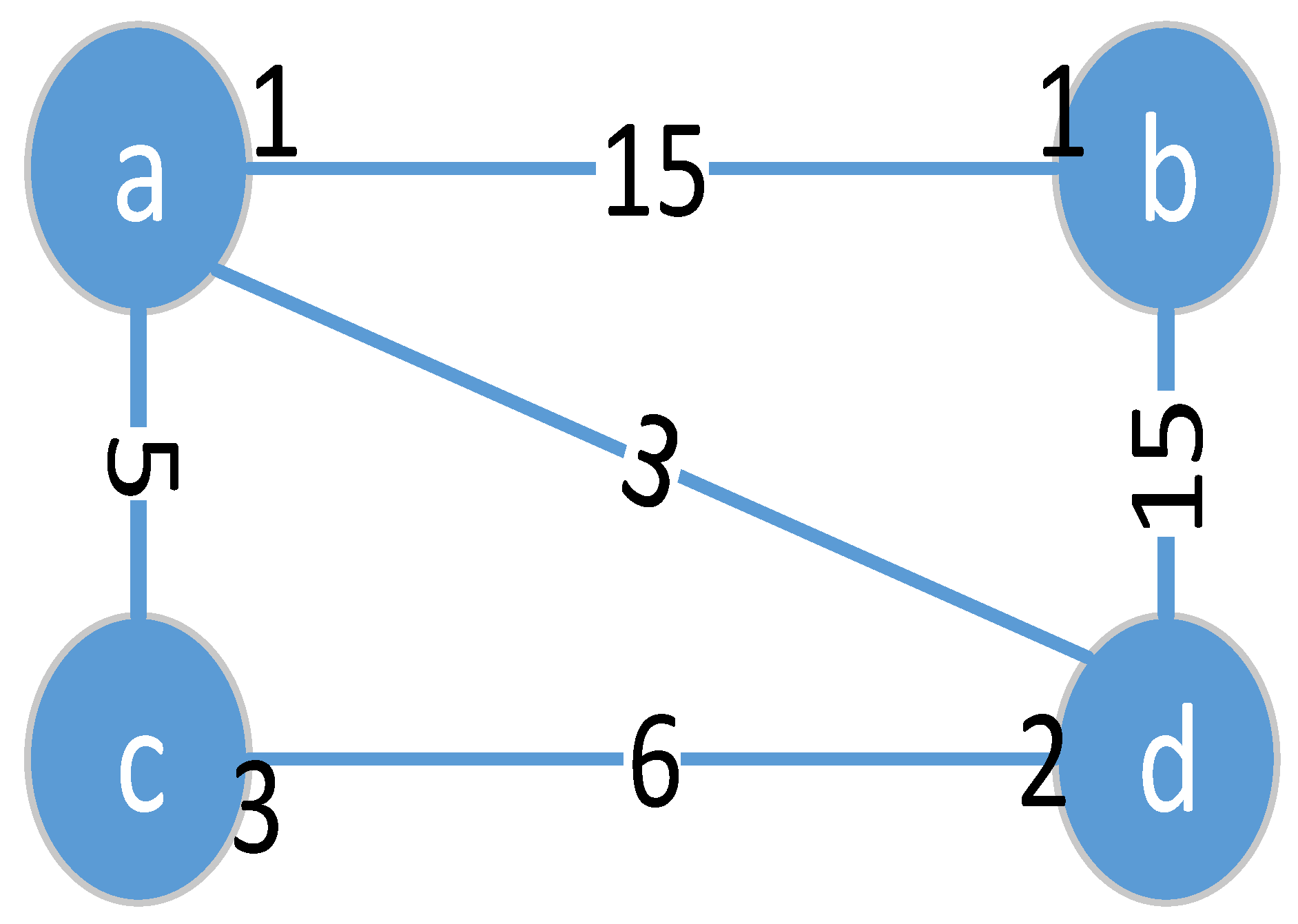
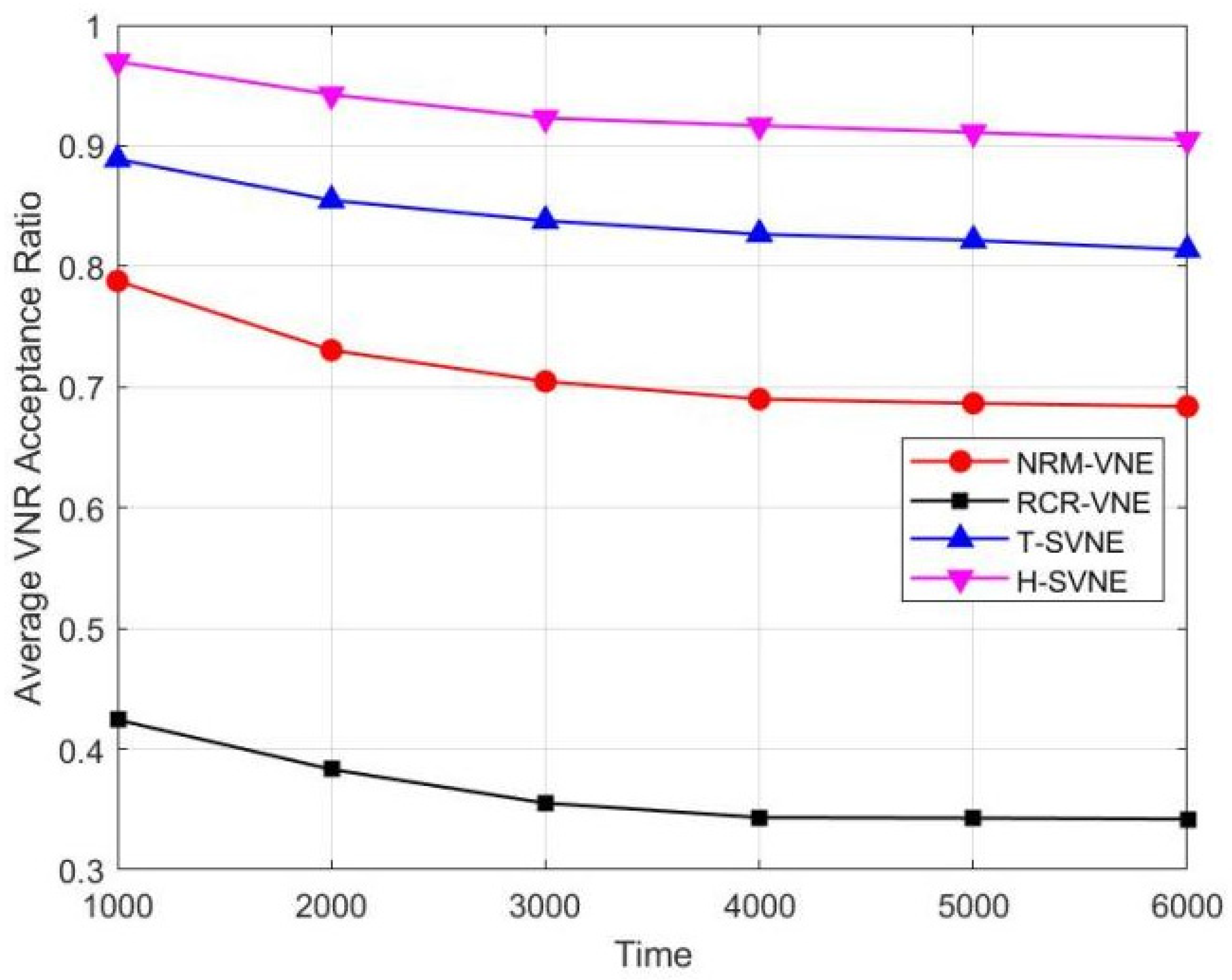

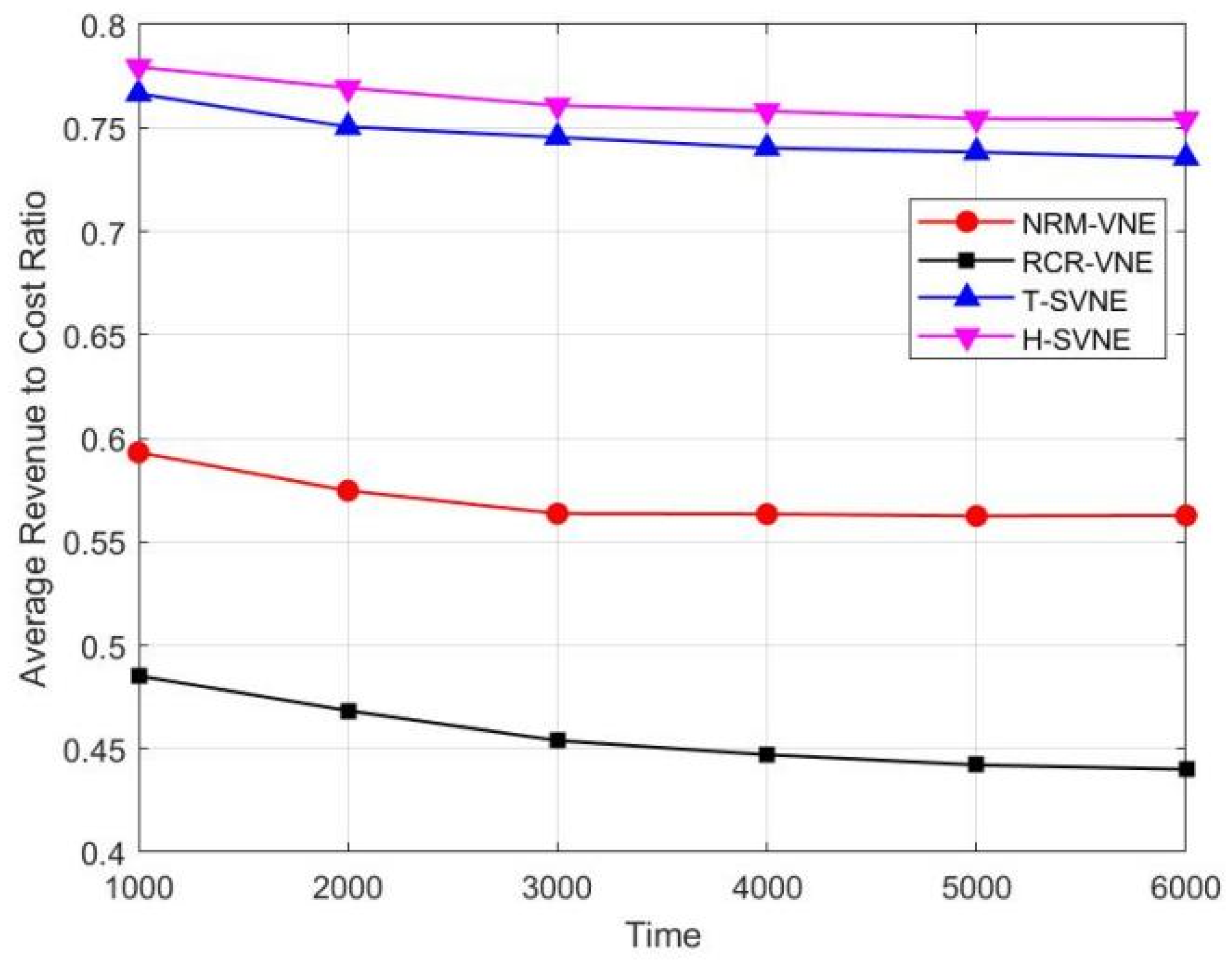
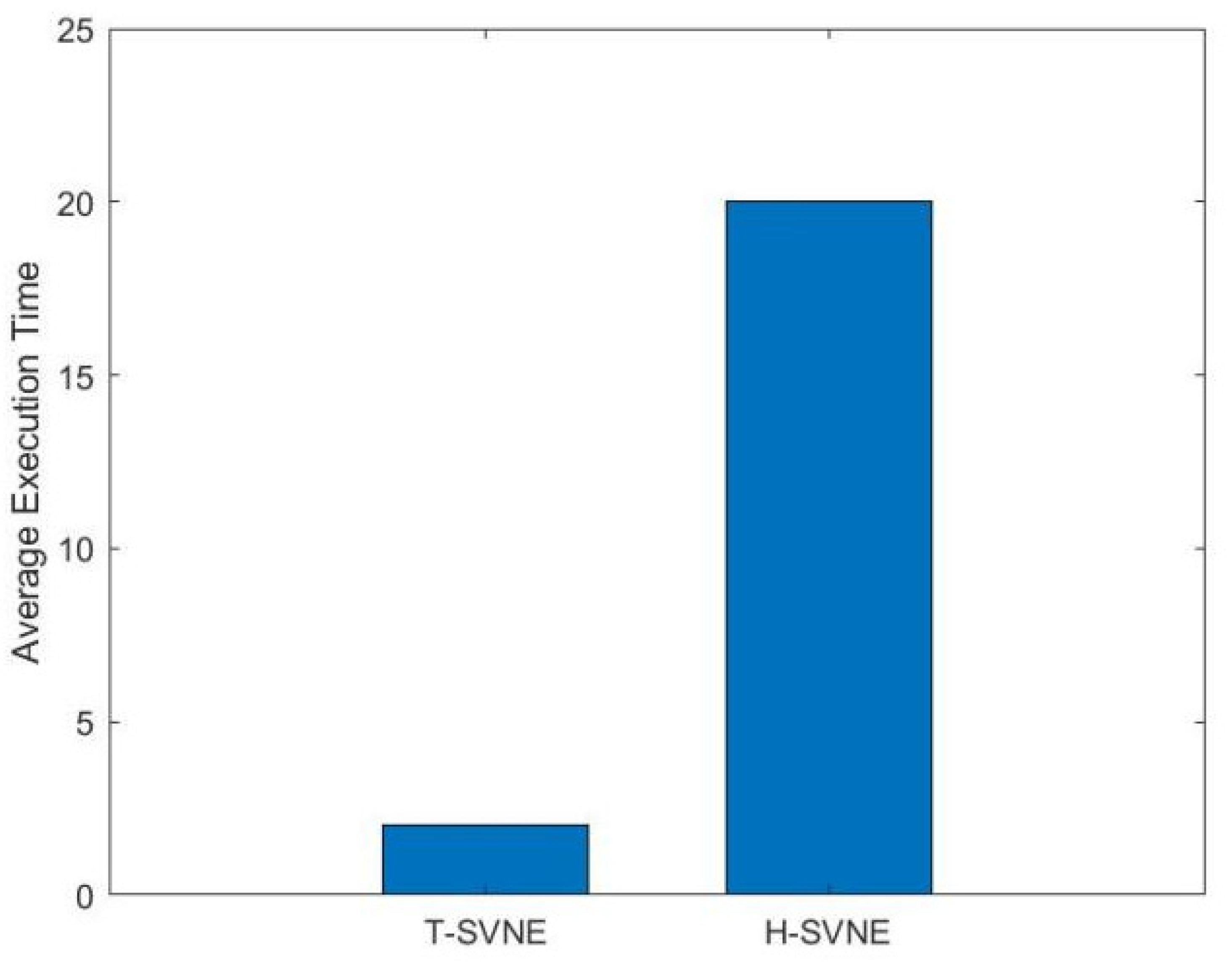
| Gs = (Ns, Ls) | Substrate network. |
| Gv = (Nv, Lv) | Virtual network. |
| i, j | Substrate nodes. |
| u, v | Virtual nodes. |
| SL(i) | The security-level of the physical node i. |
| SL(u) | The security-level of the virtual node u. |
| lij | Virtual link. |
| luv | Virtual links. |
| CPU(i) | Calculate ability of the node i. |
| TCAM(i) | TCAM capacity of the node i. |
| BW(ls) | Link bandwidth of substrate link ls. |
| TCAM(u) | TCAM requirement. |
| CPU(u) | Node calculate requirement of virtual node u. |
| BW(luv) | Link bandwidth requirement of the link luv. |
| Pst | The physical path from node s to t. |
| The coefficient of resource value. | |
| The weight coefficient. |
| Physical Network Generation Approach | Salam Method, BorderLenght = 1000, Alpha = 1010, Beta = 0.25 |
|---|---|
| Node Capacity | [80, 100], uniform distributed |
| TCAM | [80, 100], uniform distributed |
| Link Bandwidth | [50, 80], uniform distributed |
| Number of nodes | 100 |
| Security level | [0, 4], uniform distributed |
| Virtual Network Generation Approach | Salam method, BorderLenght = 1000, Alpha = 1010, Beta = 20 |
|---|---|
| VNR Arrival Rate | 4 VNRs per 100 time units |
| Number of virtual nodes | An integer, distributed [2, 10] |
| Node Capacity Demand | [25, 30], uniform distributed |
| TCAM Demand | [25, 30], uniform distributed |
| Link Bandwidth Demand | [25, 30], uniform distributed |
| Security level Demand | [1, 3], uniform distributed |
Publisher’s Note: MDPI stays neutral with regard to jurisdictional claims in published maps and institutional affiliations. |
© 2022 by the authors. Licensee MDPI, Basel, Switzerland. This article is an open access article distributed under the terms and conditions of the Creative Commons Attribution (CC BY) license (https://creativecommons.org/licenses/by/4.0/).
Share and Cite
Shen, L.; Wu, M.; Zhao, M. Secure Virtual Network Embedding Algorithms for a Software-Defined Network Considering Differences in Resource Value. Electronics 2022, 11, 1662. https://doi.org/10.3390/electronics11101662
Shen L, Wu M, Zhao M. Secure Virtual Network Embedding Algorithms for a Software-Defined Network Considering Differences in Resource Value. Electronics. 2022; 11(10):1662. https://doi.org/10.3390/electronics11101662
Chicago/Turabian StyleShen, Ling, Muqing Wu, and Min Zhao. 2022. "Secure Virtual Network Embedding Algorithms for a Software-Defined Network Considering Differences in Resource Value" Electronics 11, no. 10: 1662. https://doi.org/10.3390/electronics11101662
APA StyleShen, L., Wu, M., & Zhao, M. (2022). Secure Virtual Network Embedding Algorithms for a Software-Defined Network Considering Differences in Resource Value. Electronics, 11(10), 1662. https://doi.org/10.3390/electronics11101662






